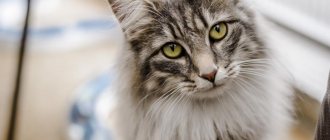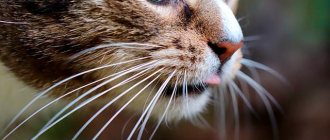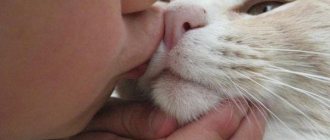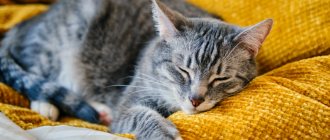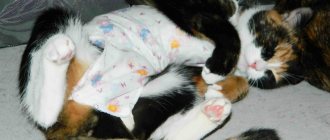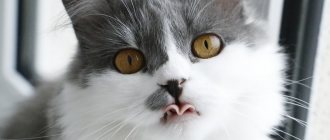Whiskered pets are the most famous warm-blooded dormouse. Their waking time is only 8-12 hours. For the rest of the day, they doze, curled up or stretched out like a sausage. Many of them snore, make funny sounds, move their mustaches and even move their paws.
All these sounds and movements confirm the presence of dreams, but what exactly cats dream about is a big mystery. There is quite a bit of research on this fascinating topic, but some questions have already been answered.
Length of cat sleep
The younger the pet, the longer he sleeps. Newborn kittens spend almost 23 hours a day in the kingdom of Morpheus. They only wake up to feed.
As you get older, your sleep duration gradually decreases. By 4-5 months, it is finally synchronized with the average, that is, 12-16 hours a day. The next change is observed only in old age, when the animal needs more time to restore its strength.
Sounds
Cats love to sleep and do so for approximately twelve to sixteen hours a day.
If the cat wants to take a nap, he will fall asleep in any convenient place that turns up, for example, on the owner’s lap, on a laptop (if he wants your attention) or in a cozy, sun-drenched corner. He needs these short sleep breaks to recuperate and reboot for the next round of feedings and playtime.
When owners learn how their furry friends' sleep patterns are organized, they quickly discover that deep sleep is not always quiet for their cats. While in dreamland, she will twitch, stretch, snore and make strange sounds. This is why a cat twitches while sleeping. These physical movements associated with REM sleep in cats are similar to human sleep behavior.
In 1959, French neuroscientist Michel Jouvet conducted a study on cats in which the atony “mechanism” was turned off. Jouvet "modified the cat's brain to disable a mechanism that prevents movement during REM sleep," writes Liz Langley for National Geographic. During NREM sleep, the animals slept peacefully, and then, entering REM sleep, "sleeping cats raised their heads as if watching invisible objects, arched their backs and behaved as if they were chasing prey and getting into a fight."
Although Jouvet was unable to prove that cats dreamed, he concluded that animals whose movement was impaired by atonia also physically responded to the images that appeared during REM sleep. This indicates the dream state.
As Jason G. Goldman noted in an article for BBC Future, in addition to studying the physical responses of animals during sleep, "researchers can now peer in humane ways into the electrical and chemical activity of animals' brain cells while they sleep." In their 2007 experiment, MIT scientists Louise Kenway and Matthew Wilson mapped brain cells in the hippocampus—the center of emotion and memory—of mice while they were awake and running through their mazes, and then while they were asleep.
“Kenway and Wilson found identical signal patterns during movement and during REM sleep. In other words, Goldman argues, it was as if the rats were mentally running through a maze while they slept. The results were so clear that the researchers were able to understand the exact locations of the rats in the mazes from their dreams and match them on a map with real points inside the real maze.” These data confirm with a fairly high probability that many animals do indeed have realistic dreams.
Phases of falling asleep
Despite the surprisingly long duration of sleep, it cannot be said that all this time cats are completely immersed in the world of dreams. Most of the time they remain responsive to stimuli, which is easily confirmed by the frequent purring of a disturbed dormouse.
The activity of the brain and other important organs depends on the phase of falling asleep. Like people, there are only two of them:
- Fast or superficial. Essential for getting ready for bed. Lasts up to 15 minutes. When dozing, the animal is tense and sensitive to any noise. In case of danger, it will easily run away or attack the offender.
- Slow or deep. Accompanied by complete relaxation of the muscles and periodic twitching of the tip of the tail and whiskers. An animal awakened during this phase needs time to recover.
In humans, most of the dreams occur in the fast phase. They are also recorded in slow motion, but they are always shorter and less emotional.
A little about the dream itself
It’s not for nothing that scientists study sleep by connecting sensors and various monitors to sleeping cats, because the sleepiest pets are very similar to people. Based on the results of such studies, it was found that even during rest, cats have high brain activity, no less than during wakefulness. However, not a single living creature can live without sleep, otherwise it is simply impossible to restore the energy expended during the day.
There are several stages of sleep: superficial (fast) and deep (slow). During the surface phase, the body of a living creature prepares for rest. But despite the fact that the animal is preparing for sleep, its nervous excitability is at its maximum. Any rustle or sound during this period of falling asleep leads to the fact that the cat immediately jumps up and is ready to run away or defend itself. Usually the surface phase lasts 10-15 minutes. You can notice how the pet is tense, and the muscles of the neck, head and limbs are in good shape.
But as soon as the deep phase begins, muscle relaxation occurs. It is noticeable how the body becomes limp, the muscles are not in good shape, and the eyeballs, closed by the eyelids, begin to move. It is this eye movement that indicates that the cat is dreaming.
Even if something wakes up a pet that was in a deep sleep phase, it will not jump up and run immediately. Awakening is slow, gradual. If the cat wakes up on its own, you will notice how it lazily and blissfully stretches out and begins to lick itself.
Do not suddenly wake up the animal unless absolutely necessary. Remember yourself when someone “pulls” you out of sleep, how your pulse accelerates, a feeling of panic and fear arises. A sharply awakened animal experiences the same thing.
Do cats and kittens have dreams – and what kind?
The presence of dreams in the cat family was first proven by the French physiologist Michel Marcel Jouvet. During the experiment, he turned off one of the parts of the brain of a sleeping cat, which is responsible for muscle activity during sleep. After the blocking was removed, the subject showed a master class in hunting while in the fast phase. He completely ignored the real mice offered to him, chasing invisible prey, which served as proof of the presence of vivid images in his head.
What color are dreams?
To begin with, it is interesting to understand whether cats see colored dreams. Scientists do not have a consensus on this issue, but with a high probability, the pictures generated by the sleeping consciousness are no different from the real world. Unlike humans, mustachioed pets see humans only in the green and blue-violet spectrum. They are also available in various shades of gray.
Do cats dream about their owners?
The images that emerge during a dream often resonate with past experiences. Despite the lack of research on this topic, the likelihood of stories involving owners is very high, since they play one of the main roles in the life of their pet.
Do cats have food and household dreams?
All subsequent experiments with the removal of the block showed that the images in the subjects’ heads were associated with very strong emotions. Based on this, scientists have suggested that cat dreams reproduce events from the past that require increased concentration (hunting) and are accompanied by nervous tension (stressful situations).
In addition to memories, human dreams are divided into desires, associated with real experience, and fantasies, associated with the imagination. Mustached pets are characterized by both. Therefore, it is likely that, in addition to chasing mice and unpleasant trips to the veterinarian, they dream of their favorite treats, favorite toys and trips to the country.
Do cats have nightmares?
Having figured out whether cats dream, we can say with confidence that nightmares are not alien to them either. Unpleasant images are accompanied by various groans, nervous tail twitching, growling and hissing. After waking up from a nightmare, the mustachioed pet will easily scratch the first person he sees, or hide under the sofa in horror.
Should I wake my cat during a nightmare?
No, don't. Do not prevent the animal from living a normal, natural life. Dreams (even nightmares) are an integral part of the body’s life. As we know, cats dream in the REM phase. There is no need to interrupt this cycle, let it end in a “normal” way. There is a risk that your pet will become very scratchy, not to say aggressive, from such a sudden awakening!
So, dear cat lovers, your pets really do dream. Perhaps even colorful. Perhaps you too have some place in them. Just don’t try to extract anything from your cat: most likely, she will immediately refuse! It's better to leave it between us!
Photo: pixabay.com
Is anesthesia also a dream?
Owners who do not know all the nuances of anesthesia often wonder whether cats dream under anesthesia. The answer to this question is easy to obtain if you understand the essence of the procedure.
Anesthetics used during surgery depress vital signs. Because of this, anesthesia is more like an artificial fainting, and not like a dream. Instead of pleasant vigor, the awakened patient feels severe lethargy and weakness.
My cat has nightmares, what should I do?
The cat is having nightmares
The cat began to behave strangely The cat is trying to hide the kitten The cat “walks” in the wrong litter box Why do other calm dogs rush at the dog Castration of a dog from a pack The dog ruins the furniture The howling of a group of dogs The cat did not accept the kitten The younger cat attacks the older one
Hello. My Cat often I have nightmares, and his behavior in my sleep starts to really scare me. He begins to sniffle heavily during nightmares, choke, twitch, hiss, and even lash out sharply after a sudden awakening. I would like to know what this could be because of. We seem to limit him from stress. And it seems he doesn’t need anything, affection, food, healthy sleep... And I would also like to ask a question, do cats really smell death? Can nightmares indicate impending death? Maybe he dreams that he is losing someone in a dream, his breadwinner or a dear friend? The question is related to the fact that today, before my eyes, three dogs tore apart the neighbor’s cat, my cat had sexual contact with her more than once, and before that, some cat had a nightmare. Moreover, I woke him up, calmed him down, and he fell asleep again and started twitching again, and do this three times... Perhaps this is mysticism, but could such an opinion exist?
I cannot deny the mystical capabilities of cats - sometimes their actions are inexplicable, but effective. Perhaps this was not the first attack of dogs on a cat, and the cat also suffered from them - this can explain the increased nervousness of the cat. Try giving him calming drops (Fitex) and using catnip or pheromones.
Good afternoon Our cat is 1 year old, Scottish Straight. His behavior has changed a little, today several times when we sleep he sits down next to us and looks at us, when we wake up, he asks to be petted and played with. In the morning the mood changed dramatically, at first he was affectionate, then he began to bite. Could this be related to the cat's requirement? Thank you in advance.
Unstable behavior may be due to sexual desire - testosterone is the hormone of aggression. If you do not plan to breed a cat, it is better to castrate him. Another reason for inappropriate behavior may be social aggression, when the cat claims your territory or your attention. In this case, you should not reinforce the cat’s obsessive behavior with encouragement and affection; it is better to ignore his pestering. It is better to communicate with the cat only on your initiative.
Please tell me what it means if a cat behaves strangely and hides the kitten in high places. She purrs restlessly and her eyes seem to be afraid of something.
The cat's restless behavior and attempts to hide the kitten indicate increased anxiety in the cat. Perhaps she senses danger from other animals or people.
Do not disturb the animal, provide it with a secluded place that it prefers (not at a height, of course) and try not to show excessive attention towards the kittens.
You can give your cat soothing drops ( Fitex
).
Good evening. They gave us a Peterbald cat, according to her documents she is 3 years old... she categorically avoids the litter box! And I tried to change the filler, treated the floor with anti-repper, put 3 trays at once in the place where she prefers to do her business... so the kitty ignored everything and continues to do her business wherever her heart pleases. Is it possible to train her to the tray?
And for what reason was it given away?
If a cat has an established reflex of uncleanliness, it will be difficult to retrain it.
Try offering different types of litter and use the one your cat chooses. During training, she needs to be kept in a limited space with a tray so that she has no other option but to “go” to the tray.
But the forecast for the restoration of cleanliness is cautious...
Hello! Please tell me why other completely calm dogs rush or bark at my dog (German shorthaired pointer breed) (in general they don’t like it)? My age is 2.5 years.
Obviously, due to your dog's behavioral characteristics, a more detailed history is needed. Counter aggression can be provoked by aggression or inappropriate behavior of your dog, as well as fear on the part of the shorthaired pointer. Calm, balanced dogs will not rush at a calm dog that is indifferent to other brothers.
Your behavior can also play the role of a trigger - if the owner begins to pull his dog away in advance, screams, makes sudden movements - this can also cause an aggressive reaction from other dogs.
I take care of a flock of dogs, it so happened that one was caught, now he has been vaccinated and in 10 days they want to castrate him, and then they will return him back, please tell me, is it worth castrating him? Will the pack's attitude towards him change? Will they drive him out? It is estimated that the dog will be absent from the pack for almost a month! The dog is young, 9 months old.
How long do cats sleep after anesthesia?
The behavior of pets and their condition after surgery always worries worried owners.
If a cat is about to be sterilized, then naturally the owner will be concerned about how much she will sleep after the operation. The body cannot ignore anesthesia, so after it and surgery it will take time to recover. Some creatures recover from anesthesia very quickly and wake up immediately, while others take longer.
If we are talking about a cat, then the question of how long he will sleep after castration also has an answer: it all depends on the individual characteristics of the pet’s body. In any case, he will need the care and attention of his owner. The veterinarian will definitely give important recommendations on this matter.
Cat's dream and human's
Let's start with the fact that a cat's sleep has the same cycles as a human's. Purrs also go through the so-called rapid eye movement (REM) sleep phase, during which we all dream - pleasant and not so pleasant. So it is quite logical to assume that cats dream. And they are fundamentally no different in content from ours: cats in their dreams experience what they recently saw, the events they witnessed. Hunting, playing, “socializing” with other cats and all that jazz.
In 1965, French scientists Jouvet and Delorme conducted a very interesting study, during which the so-called pons of the brain was removed from an experimental cat. After the operation, the animal was unable to lie still (well, or twitch a little) during sleep. On the contrary, in a state of sleep the cat walked, and even behaved aggressively! This discovery prompted the researchers to the right idea - in their sleep, cats rethink their experience. And they seem to be able to separate dreams from what they see in reality. Just like you and me.
How much time do cats spend sleeping?
The total sleep time of cats per day is from 15 to 20 hours. It is not a continuous dream from start to finish. An adult cat may nap several times a day.
Each cat has its own sleep norm. The duration of sleep during the day is also affected by the activity of the animal. If the cat walked a lot and actively moved, then he will sleep for a long time.
If the cat has not slept, he can do this at any time convenient for him. Even if the pet wakes up from any sound, he can immediately fall asleep again.
If a cat, which is the longest sleeping creature among mammals, suddenly sleeps little, it means it is stressed. The problem can be serious, it needs to be solved.
A newborn kitten's sleep patterns will be different. Kittens tend to nap near their mother. Babies wake up only to feed. Over time, the proportions of rest and activity change: the kitten sleeps less and moves more.
The elderly cat seems to be falling back into childhood and sleeps a lot. An old cat wakes up only to perform its natural needs and to feed.
How and when do cats sleep?
If a cat does not sleep at the required hours, being in a relaxed state, but looks for a secret place for dreams, it means that she is not so comfortable next to her owner. Normally, a cat would rather prefer the master's bed than the corner under the sofa. An animal that completely trusts its owner easily falls asleep on his lap, turning over on its back and putting all four paws in front of it.
When a cat is 9 years old, she slept for about 6 years of that time.
The place to sleep will most often be located at some elevation, and it will be something soft and warm. The cat will stomp on the chosen bed, stretch, relaxing every muscle, and very quickly falls asleep.
Do cats dream in color?
Researchers are still arguing about this topic. In particular, many problematic issues related to human sleep have not been resolved. What can we say about a cat's sleep! Today, the prevailing point of view is that dreams in color are seen exclusively by emotional, expressive people.
As for cats, there is no consensus. Some scientists believe that cat dreams are woven from pictures in gray and blue tones. Others believe that yellow is added to these two colors. Be that as it may, color perception is significantly different between humans and cats due to differences in eye anatomy. Still, a human eye and a cat’s eye are not the same thing!
Perhaps those scientists who believe that cats have the most ordinary color dreams are also right. Only in slightly muted colors, not so bright. Where is the truth? We will find out over time, science does not stand still.
Sleep phases of cats
People who have cats in the house can constantly observe how a seemingly soundly sleeping pet suddenly jumps up and rushes at maximum speed to the kitchen, to the owner or to the door. For cats that have become well-adapted to resting during light naps, waking up abruptly is normal. These animals constantly pick up information from everywhere, so there is nothing strange in such a rapid succession of states.
Cat dreams are divided into two phases, which replace each other:
slow phase: decreased blood pressure, low muscle activity, decreased heart rate, slow breathing. The eyes under closed eyelids, at the moment of falling asleep, slowly move a little and then stop
fast phase: rapid heartbeat, change in breathing rate, rapid rotation of the eyes, slightly increased blood pressure and body temperature, possible shudders, movement of the limbs and ears.
The fast phase in adult cats takes up to 25% of the total time, in old cats 15%. The slow phase lasts 20-30 minutes, and then it is replaced by a fast phase for 5-7 minutes. Over a long period of sleep, the phases alternate several times.
Cats sleeping problems
In cases where a cat, not exceeding its usual sleep norm, suddenly begins to constantly doze off and look drowsy, it is first determined whether this is due to pregnancy or weather conditions (excessive heat or extreme cold). If a cat spends more than 18 hours sleeping, then such drowsiness may come from some kind of disease. A cat's sleeping position can help identify the problem: a frozen posture like a sphinx or attempts to spread its limbs that are unusual for an animal indicate hyperthermia. Also, an excessive amount of sleep is an indicator of the onset of heart problems.
Other sleep disorders include insomnia. Stress caused by moving, the arrival of a new family member, or an influx of guests may be to blame here. Sometimes cats have seizures in their sleep - it’s better to film any oddities and then show it and the animal to a veterinarian.


